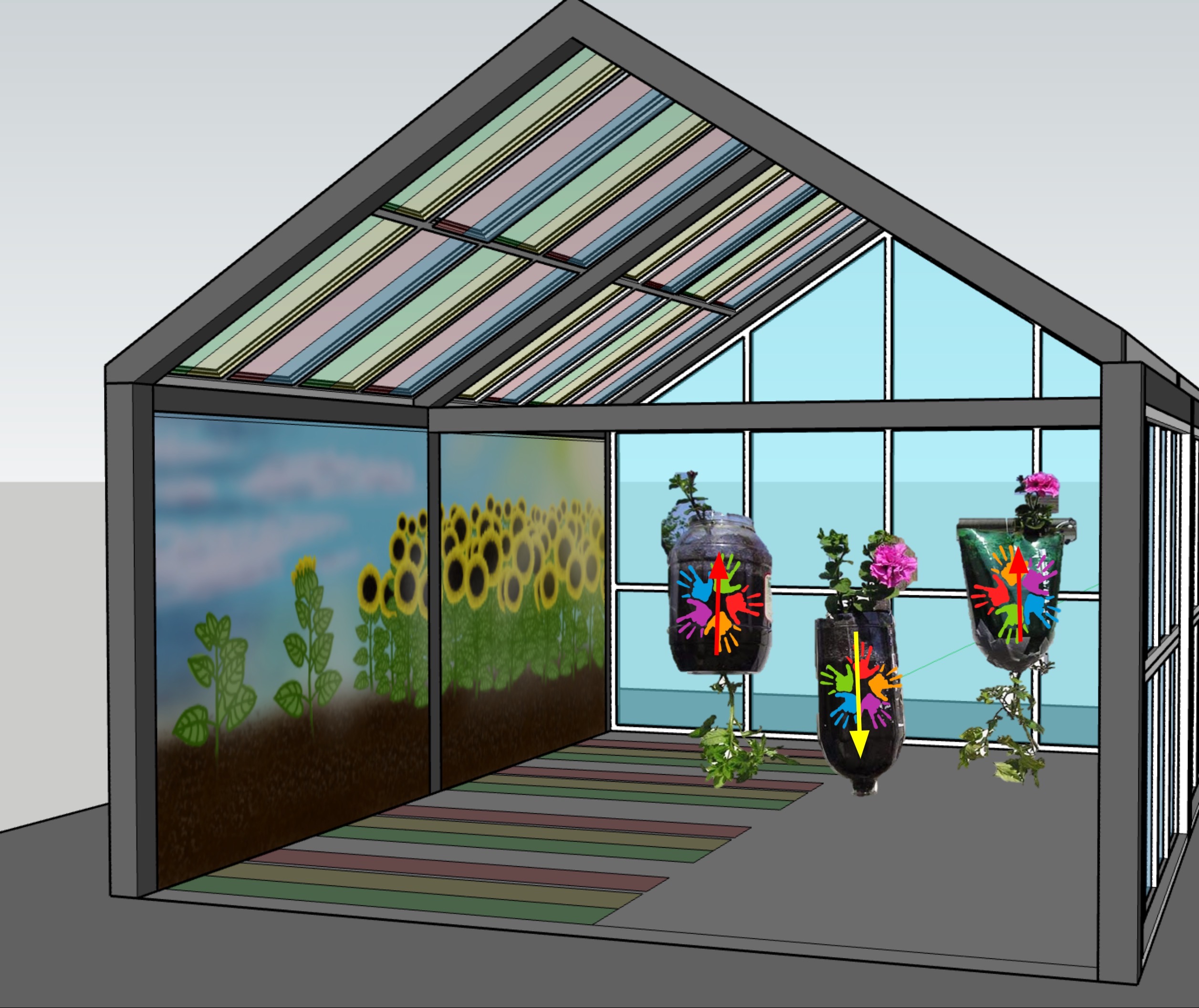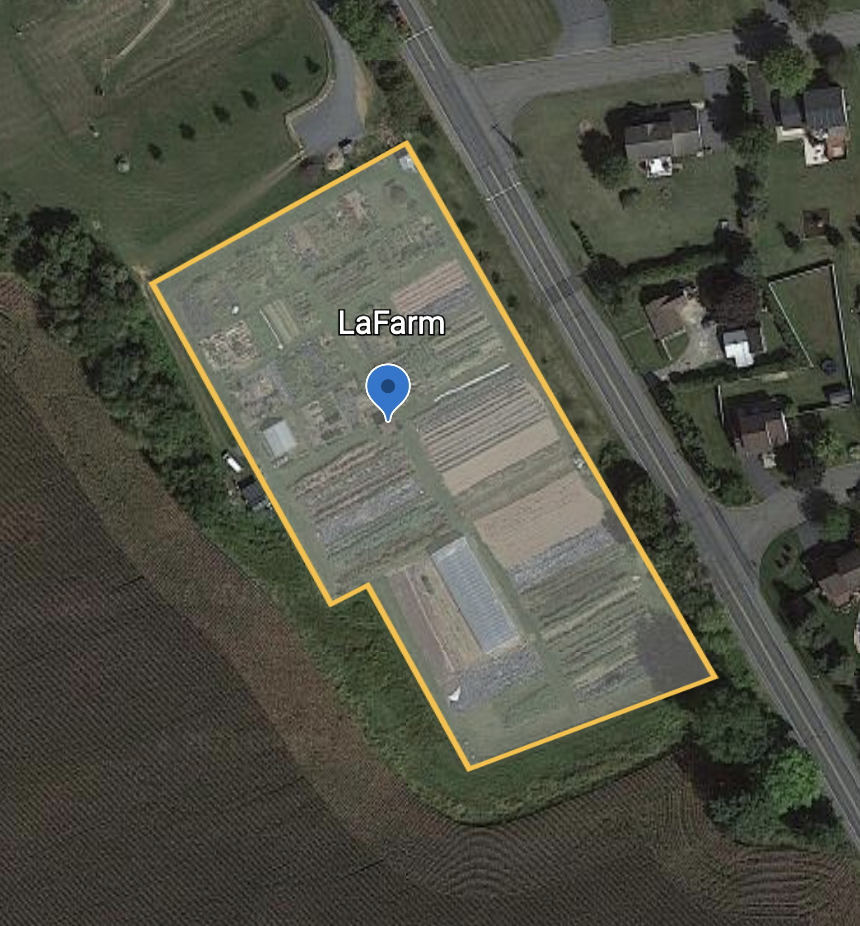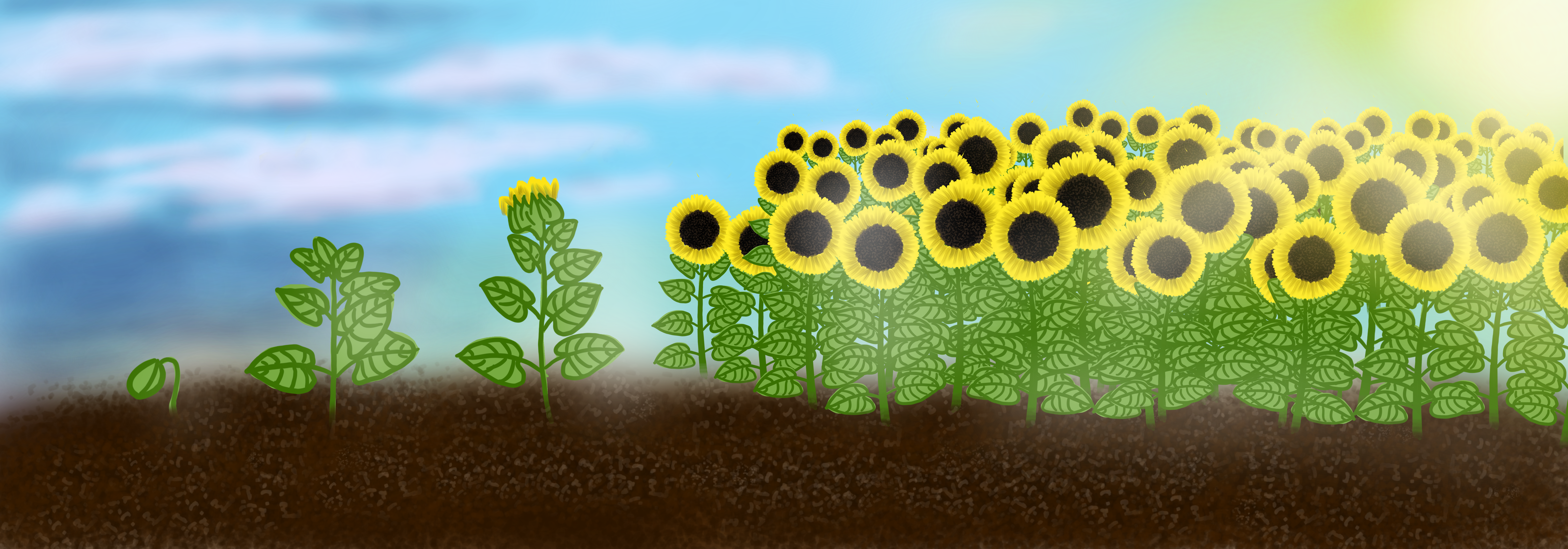< Previous Section (Cover Page)
Next Section (Social Context) >
LaFarm and Engineering Studies at Lafayette College
Based at Lafayette College (LC), a liberal arts college in Easton Pennsylvania, the Engineering Studies major (EGRS) is focused on ethical engineering that places community values at the centerpiece of engineering projects. This report is a proposal by a group of senior undergraduate Engineering Studies students to install functional art at LaFarm, Lafayette’s community garden, as a chance to exercise appropriate engineering practices. Our plan entails the addition of 3 artistic elements to the existing greenhouse construction plans at LaFarm. These are dye-sensitized solar cells on the roof, upside-down hanging planters made from recycled materials and decorated by students, and a painted mural on the two longer side walls of the greenhouse (see Figure A below). LaFarm has already been formulating construction plans for a working greenhouse for years, and we believe that adding artistic installations to this piece of infrastructure is an opportunity to add value without taking up additional space on the farm.

Fig. A: 2D model showing the greenhouse with dye-sensitized solar cells (roof), upside-down hanging planters made from recycled materials and decorated by students (inside), and one of two painted murals (left side wall). As created by authors.
Here we see an opportunity to visually solidify aspects of LaFarm’s collaborative nature, respect for the environment, and personal connection to food production through a central piece of artistic infrastructure. This report sought to utilize functional farm art as a way to promote feelings of inclusivity, belonging, accessibility, and connection not just among regular participators, but the wider body of students, community members, and faculty to the farm itself. Incorporating solar power, light, and human interaction into our plans is essential, as it brings new dynamic elements and life to the space. Overall, this proposal’s goal is the beautification of the farm, enhancement of the visitor’s experiences, and representation of LaFarm’s values through artistic additions. Our group was poised to help achieve these goals, as we were eager to put our community-centric engineering values to the test.
What is LaFarm?
LaFarm itself is small, as it covers just under 3 acres and sits 3 miles north of Lafayette’s College Hill campus. Situated adjacent to LC’s Metzgar Fields Sports Complex and a quiet suburban neighborhood, LaFarm provides a quaint escape from the constant activity of College Hill, an opportunity for students and local community members alike to reconnect with the earth and grow food by hand (see Figure B below). The operation is a farming and gardening initiative under the Office of Sustainability at Lafayette. They grow food for our dining halls, compost food waste, and facilitate student-faculty research and collaborate with the curriculum of the sustainability, environmental studies, Geology, EGRS, and more departments (LaFarm Website). LaFarm has seen great successes since its inception in 2009 with an increase in student participation each year since (Lisa Miskelly). Although growth was once a main goal of LaFarm, focus has shifted to more effectively operating under a greater yield and higher demand for both produce and farming opportunities while adhering to their core values.

Fig B: Aerial view of LaFarm, captured by Google Earth in September of 2020.
Lisa Miskelly, the Assistant Director of Food and Farm at LC is an integral contact for this proposal as a leader of all operations at LaFarm. In our group’s video interview and in-person farm walkthrough with Miskelly, she provided us with multiple important values of LaFarm to incorporate into our project. Supplemented with information from the LaFarm website, we were able to carve out these pillars to guide our proposal.
First on our list of priorities was community engagement. LaFarm is supported by student volunteers, workers, and college clubs while working with school groups outside of the college, including local daycares, preschools and middle schools. LaFarm also offers rentable community gardening plots available on a per-season basis, open to the easton community. Our project seeks to engage the community by enlivening the space, thus making the farm itself more attractive to Easton residents and Lafayette students, while fostering a deeper feeling of connection to the diverse nature that lives there.
This is related to the value of environmental sustainability, which includes Miskelly’s idea of Lafarm being a “Responsible steward of the natural world.” Although LaFarm is not certified organic, they still closely follow organic guidelines and practices. Also, LaFarm employs carbon storage, composting, and rich biodiversity (including plants, animals, and pollinators) for a healthy farm environment. As it applies to this project, we avoided any projects that would impact the surrounding ecosystem negatively in any way. Utilizing solar cells will reduce the energy footprint of the Greenhouse through substituting some of it’s terrestrial power with clean solar power. Additionally, the upside-down planters are made from recyclable materials and require no new equipment to be produced.
Outside of typical community garden operations, LaFarm’s relationship with the college provides unique opportunities in curricular integration. Lafayette’s student curriculum is intertwined with LaFarm and the services they provide for students. For example, they facilitate multiple First Year Seminar (FYS) courses, a tractor conversion engineering project, the sustainable food loop, and of course, the EGRS department. This is of course also related to community engagement, as integration with the curriculum of Lafayette introduces students to the prospect of working at LaFarm.
Finally, LaFarm at its core seeks to produce healthy, locally grown food. They also have weekly food delivery for on-campus and college hill students and residents. Bon Appetit, the LC dining service, uses LaFarm produce for Lafayette’s Marquis dining hall, Upper Farinon dining hall, and Trolley Stop diner. It was crucial for this proposal to not disturb the materially productive aspects of LaFarm by not impeding the actual farm work, but rather making it more enjoyable. With the addition of a new greenhouse, LaFarm will have a permanent home for their more sensitive plants before they are to be transplanted to the crop plots. Also, the upside-down planters will slightly increase capacity for growing food.
Our project is predicated on the desire to maintain and amplify each of these goals with our proposal. Therefore, we had to keep these pillars in mind as we designed our installations and fitted them to the LaFarm space.
Our Project
As we crafted ideas for planned functional art installations that add artistic value and promote LaFarm’s established goals, Lisa Miskelly cautioned us against investing in projects that prompt excess space usage and maintenance. The only areas within LaFarm that aren’t either a walkway, farm plot, or existing piece of infrastructure are currently free for parking spots and facilitating movement of larger pieces of equipment. Lisa noted that an artistic sculpture was once placed in one of these free spaces, but was difficult to work around, weed, and maintain. Eventually, the piece was moved into storage. As for the greenhouse, plans have been in the works for years at LaFarm. Existing community plots would be rearranged to make room for the new structure. Applying additional artistic elements would serve as an aesthetically pleasing addition that would not take up more land area than what is already allocated to greenhouse space.
The three greenhouse installations proposed in this report are the dye-sensitized solar cells, upside-down hanging planters, and stained glass murals. Each of these components seek to embody LaFarm’s core pillars while providing additional functionality to their operations.
First, the dye-sensitized solar cells are multicolored, translucent panels installed on the roof. Not only do these offset some electricity costs for the greenhouse itself, but they also cast beams of colored light into the greenhouse, as sunlight enters the roof and bounces off the walls, equipment, and floor. This displays the flow of heat from the sun that keeps the contained plants healthy, thus visually representing the important role that the sun has in the growing of plants, specifically within a greenhouse.
Next, the upside-down hanging planters provide additional growing space for the greenhouse, and area for students to contribute their artistic style. When the greenhouse is finally constructed, Lafayette students will have the opportunity to personally beautify the planters with a decoration event on the quad. Therefore, students who are not usually involved in LaFarm operations can contribute to equipment that farm volunteers and workers can use often. Additionally, the planters are made simply with recycled bottles and containers, emphasizing LaFarm’s commitment to sustainability.
Last, the stained glass murals painted on the long sides of the greenhouse provide artistic imagery that reflects the values and purpose of LaFarm, thus strengthening and amplifying those values for the LaFarm community. One side features the community engagement, environmental sustainability, and food production aspects of LaFarm’s core pillars, and the other features a visual representation of photosynthesis to reinforce the living, breathing nature both around and within the greenhouse itself (see Figure C below). Incorporating this proposal into the greenhouse plans can essentially satisfy our desire to implement artistic functional infrastructure while simultaneously giving LaFarm something they can use for food production for years to come.


Fig C: Sketches of stained-glass murals featured on the sides of the new greenhouse. As created by authors.
It is crucial to consider as many contributing and limiting aspects as possible when planning an engineering project, no matter the size, budget, or overall impact. Even in relatively simple projects like these, having a full understanding of all the factors at play and incorporating them into our plans will greatly contribute to the success of this undertaking. We want to create something that workers, visitors, and the administration can all not only be proud of, but that also can be easily maintained in the future so the outcomes are as long lasting, beneficial, and frictionless as possible for all parties involved.